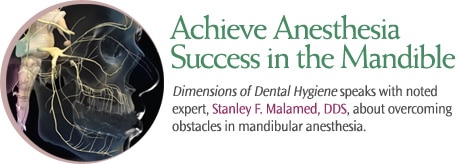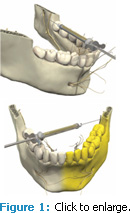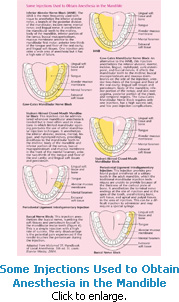
Achieve Anesthesia Success in the Mandible
Dimensions of Dental Hygiene speaks with noted expert Stanley F. Malamed, DDS, about overcoming obstacles in mandibular anesthesia.
Q Why is local anesthesia easier to attain in the maxilla?
A The cortical plate of bone overlying the teeth in the adult maxilla is considerably thinner than in the mandible. This permits a local anesthetic (LA) infil trated in the buccal fold at or above the apex of a tooth to readily diffuse through this thin plate of bone and block the nerve(s) entering into the apex of the tooth, providing pulpal anesthesia. On rare occasion the cortical plate may be thicker than normal, and infiltration anesthesia may fail. Fortunately, there are nerve blocks, such as the poste rior superior alveolar (PSA), anterior supe rior alveolar (ASA), and anterior middle superior alveolar (AMSA) blocks, that can easily compensate for this situation.
Q What are the most common problems associated with mandibular anesthesia?
A Failure to achieve pulpal anesthesia is the biggest problem in the delivery of local anesthesia (LA). The traditional inferior alveolar nerve block (IANB) has a rather sig nificant failure rate (Figure 1). Pub lished studies have demonstrated failure rates from about 15% to as high as 40%.1-3
Because about half of all injections adminis tered in dentistry are for mandibular proce dures and simple infiltration anesthesia does not normally provide pulpal anesthesia (due to the thick cortical plate of bone found in the adult mandible), providing successful mandibular anesthesia is often frustrating to the dentist and dental hygienist.
Q What are some suggestions for suc cessfully achieving anesthesia in the adult mandible?
A Given that the anatomy of the injec tion site for the IANB is quite vari able and there are no consistently obvi ous landmarks to aid in guiding needle insertion, the success rate of this injec-tion is relatively low. The most common reason for missing the IANB is depositing the LA below the mandibular foramen, the site at which the inferior alveolar nerve enters the mandibular canal. Most experienced LA administrators have learned through experience that this is the case. Having administered what felt like a successful IANB (eg, the depth of needle penetration that is typically felt with an effective injection) but having no pulpal anesthesia occur (eg, no lip, no tongue), the subsequent reinjection is administered higher—perhaps 5 mm or 10 mm above the previous injection site. And, in many cases, profound anesthesia develops.
Additionally, having the patient sit comfortably upright after the injection seems to help provide a more rapid onset and more profound anesthesia. This assumes that the patient was placed in a supine position for the injection (to mini mize the occurrence of psychogenic reac tions, such as loss of consciousness and hyperventilation).
Other techniques, such as the Gow Gates mandibular nerve block and the Vazirani-Akinosi closed mouth mandibu lar nerve block, were developed primarily because of the poor success rate of the traditional IANB. Not coincidentally, both of these techniques deposit the LA at sites higher than the IANB. The periodontal ligament (PDL, ILI [intraligamentary]) injection and intra osseous anesthesia have become impor tant techniques in the dental armamen tarium, primarily when seeking anesthe sia of mandibular molars. More recently, the use of articaine HCl by mandibular infiltration has received much attention. Deposition of a full car tridge in the buccal fold adjacent to the tooth being treated following IANB has significantly increased success rates.4-6 And, of course, the reliable incisive (mental) nerve block is useful. Depositing 0.6 ml of LA outside the mental foramen and then pushing the drug into the fora men with finger pressure (minimally 1 minute, preferably 2 minutes) provides pul pal anesthesia to the premolars, canine, and incisors, along with the buccal soft tis sue and bone surrounding these teeth.
Q Is the buccal nerve block used for mandibular anesthesia?
A Yes, but this injection provides pain control only to the soft tissues buccal to the mandibular molars. It is only indicated when manipulation of the soft tissues is required, such as in therapeutic scaling and root planing and soft tissue curettage. It is a technically simple injection with a high success rate.
Q Are topically delivered anesthetics an appropriate first step when providing injections?
A Absolutely. Regardless of the topical drug formulation used, application of a small amount of topical anesthetic will anesthetize the outermost 2 mm to 3 mm of mucous membrane, permitting insertion of the needle to proceed painlessly. Combined with stretching of the tissue during insertion and slow deposition of the local anesthetic, virtually all injections can be administered in a way that assures patient comfort.
REFERENCES
- Malamed SF. Handbook of Local Anesthesia. 5th ed. St. Louis: Elsevier Mosby; 2004.
- Kaufman E, Weinstein P, Milgrom P. Difficulties in achieving local anesthesia. J Am Dent Assoc. 1984;108:205-208.
- Potocnik I, Bajrovi? F. Failure of inferior alveolar nerve block in endodontics. Endod Dent Traumatol. 1999;15:247-251.
- Malamed SF, Gagnon S, Leblanc D. Articaine hydrochloride: a study of the safety of a new amide local anesthetic. J Am Dent Assoc. 2001;132:177-185.
- Malamed SF, Gagnon S, Leblanc D. Efficacy of articaine: a new amide local anesthetic. J Am Dent Assoc. 2000;131:635-642.
- Simon MA, Vree TB, Gielen MJ, et al. Similar motor block effects with different disposition kinetics between lidocaine and (+ or -) articaine in patients undergoing axillary brachial plexus block during day case surgery. Int J Clin Pharmacol Ther. 1999;37:598-607.
From Dimensions of Dental Hygiene. October 2010; 8(10): 28, 30, 32.


